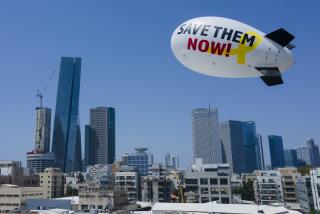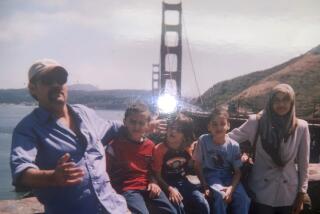U.S. Boosts Somalia Troops After 12 Die : Africa: Casualty figures more than double; six are held hostage. Deadly incident threatens Clinton policy.
- Share via
WASHINGTON — President Clinton ordered new U.S. troops and weapons to Somalia on Monday in the wake of a bloody military operation Sunday that left 12 Americans dead, 78 wounded and at least six held hostage.
The casualty figures, more than double what officials had estimated only a day earlier--and the fact that some U.S. service personnel have been taken hostage--marked a major escalation in the military confrontation in Somalia and seriously threaten Clinton’s policy there.
The Pentagon had earlier reported that five Americans had been killed and 24 wounded Sunday, with the loss of two Blackhawk UH-60 attack helicopters, in a U.N. military operation in southern Mogadishu, the Somali capital.
In Mogadishu on Monday, dozens of cheering, dancing Somalis dragged the body of a U.S. soldier through the city’s streets.
The U.S. reinforcements sent Monday included 220 more Army Rangers, 4 M1A1 tanks, 14 Bradley fighting vehicles, two replacement Blackhawks and 200 other troops to relieve units now stationed in the East African nation.
Defense officials also said that the Air Force would send two AC-130H gunships, which contain precision-guided 105-millimeter howitzers and a variety of other high-tech weapons, to help rout the forces of warlord Mohammed Farah Aidid in south Mogadishu. The aircraft were used briefly there in August.
The potential political impact of having U.S. servicemen held hostage by Aidid was demonstrated graphically Monday, when CNN broadcast a videotape of an American being held by Aidid’s organization. The man on the tape identified himself as a Blackhawk helicopter pilot, Army Chief Warrant Officer Michael J. Durant. The Pentagon said his unit is based at Ft. Campbell, Ky.
In a scene reminiscent of those played out when U.S. POWs were captured by Iraq during the Persian Gulf War, a clearly battered Durant mumbled that “as a soldier, I have to do what I’m told.” Asked on the tape about his own role, he replied nervously, “Innocent people being killed is not good.”
Within minutes after the videotape had been played, the President and his top officials cautioned Aidid’s forces against any mistreatment of U.S. hostages, warning that the United States would act on its own--without U.N. authority, if necessary--to retaliate.
“If anything happens to them (the U.S. hostages),” the President said, “. . . the United States--not the United Nations, the United States--will view this matter very gravely and take appropriate action.”
Defense Secretary Les Aspin issued a similar admonition, warning that “we will respond forcefully if any harm comes to those who are detained.” And Secretary of State Warren Christopher warned, “We’re not going to go through any international body to debate.”
The Pentagon identified four of the dead soldiers as: Pfc. James H. Martin Jr., 23, 10th Mountain Division, Fort Drum, N.Y.; Pfc. Richard W. Kowalewski Jr., 20, 75th Ranger Regiment, Fort Benning, Ga.; Sgt. James C. Joyce, 24, 75th Ranger Regiment, Ft. Benning, Ga., and Chief Warrant Officer Clifton P. Wolcott, 36, 160th Special Operations Aviation Regiment (Airborne), Fort Campbell, Ky.
Clinton told reporters that he would return to Washington today after a stop in Los Angeles on Monday night and expects to have “more to say about (the Somalia situation) in the next 48 hours,” presumably after meeting with his national security advisers.
Meanwhile, he indicated that the United States has no plans to change its Somalia policy, despite the weekend setback, and that U.S. troops will remain in the country until security is restored sufficiently to allow the political structure to be rebuilt.
Still, U.S. officials conceded that the Administration faces major uncertainties over the future course of the U.N. effort in Somalia, both in terms of how Aidid’s forces would respond to the situation and how Congress would react at home.
Lawmakers, who demanded three weeks ago that the Administration provide a detailed exit strategy by Oct. 15, called Monday for the White House to take a “hard look” at its current policy and for the United States to withdraw its troops.
Senate Minority Leader Bob Dole (R-Kan.), who initially had supported the U.S. intervention in Somalia, said the Administration should seek the approval of Congress to alter the original mission of U.S. forces in the country.
But Capitol Hill strategists said that there still is relatively little support for any immediate congressional move to blunt the Administration’s policy and predicted that the lawmakers would defer any action until the Oct. 15 deadline that they have set.
For all the dismay over the military losses that U.S. forces suffered, officials said the Ranger operation resulted in the capture of two more of Aidid’s top lieutenants--Interior Minister Osman Salad and Foreign Minister Wali Hassan--who were the major targets of the raid.
The arrests of the two men is important because U.N. officials have been banking on such tactics as a way to weaken Aidid’s Somali National Alliance in lieu of actually arresting the general. Last month, they caught Osman Ato, Aidid’s chief financier.
The weekend’s operation consisted of a series of clashes between U.S. forces and Somali militiamen that eventually involved some 400 American troops. It proved to be one of the biggest--and most costly--U.S. strikes since American troops were sent last December to help establish security so that food could be distributed to a starving nation.
Military officials said the most critical battles began in midafternoon Sunday, when about 90 U.S. Rangers, acting on intelligence reports, raided the Olympic Hotel in downtown Mogadishu in hopes of capturing Salad and Hassan.
Although the initial mission was successful--the Rangers captured 19 of Aidid’s men--the mission went awry when a Blackhawk helicopter sent to help secure the area was hit by ground fire, forcing ground troops to mount a rescue operation.
About 70 of the Rangers surrounded the downed helicopter, forming a perimeter to protect wounded crewmen, but the fire they encountered from militiamen proved far heavier than expected, effectively pinning down the U.S. troops.
A few minutes later, a second U.S. helicopter crashed 2,000 yards away and a third chopper--also a Blackhawk--was hit and had to leave the area. Six chopper crewmen are still missing.
Facing a serious threat, the Americans called in the Army’s Quick Reaction Force, bolstered by U.N. troops with armored vehicles from Pakistan, the United Arab Emirates and Malaysia. Shortly after dusk, the task force arrived to help.
But again, the U.N. forces were kept at bay by the heavier-than-anticipated fire from the Somalis, and it was not until 2 a.m. Somali time that the task force was able to drive the militiamen away and evacuate the wounded.
Besides the Americans who were killed, one Malaysian soldier was killed and six others were wounded and two Pakistani troops were wounded. Somali spokesmen said that several hundred Somalis also may have been killed or wounded.
* U.S.-U.N.TENSION: U.S. policy on Somalia dismays, perplexes U.N. officials. A10
More to Read
Sign up for Essential California
The most important California stories and recommendations in your inbox every morning.
You may occasionally receive promotional content from the Los Angeles Times.








